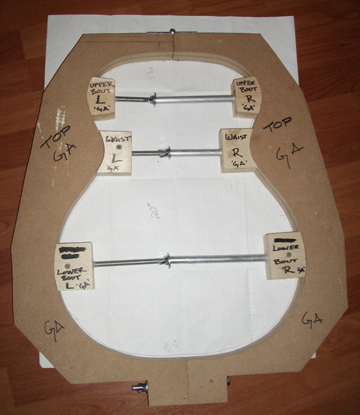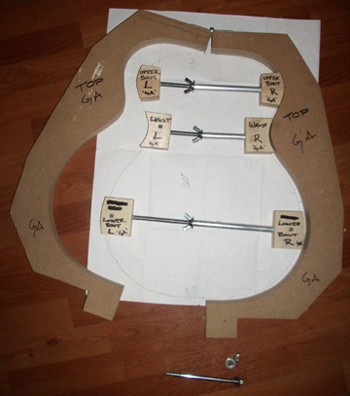I start with a half pattern of the outline of the guitar, cut from 1/4" tempered Masonite or acrylic. The inside curve is the guitar shape, and it's about 2" wide above the shoulders and below the hips, with those curves connected by a straight line. I drill a half dozen, 1/4" holes in it spaced more or less evenly. The ends of the pattern are cut off exactly on the centerline of the guitar.
I trace this pattern four times onto a piece of good quality plywood, around 5/8" thick. Rough cut those out, staying clear of the line by 1/16" or a little more, on the bandsaw.
Clamp the pattern down to one of the plywood pieces so that it's reasonably centered, and drill through the plywood using the 1/4" holes in the pattern as a guide. Then use stubs of 1/4" dowel to pin the pattern to the plywood.with the dowels flush with the pattern surface, and remove the clamps. Use a top-bearing pattern following bit in the router to cut the plywood to exactly the shape of the pattern. If you're using Masonite, wax the edges before routing.
I then cut 2" squares of the scrap ply and drill 1/4" holes in the centers. Stack glue two of the ply cuttouts with spacers in between, using 1/4" dowels as locators. I use a flat bench top ad my go-bar deck for this. Check carefully with the square in two places that are 90 degrees out of line, such as above the shoulders and below the hips, to be sure you don't build in any twist or sideways displacement. Do not put spacers in the holes closest to the ends.
When you've got two of these half mold stacks glue them together using a plywood bridging piece about 5 or 6 inches long. This can be drilled out and pinned after the glue is dry for extra strength. If any of the spacers hang out, the laminate trimmer will get them.
The resulting mold is a bit more than 2" high, which is enough to ensure that the sides are perpendicular but not so tall as to get in the way when you're sanding the edges in the dish or clamping on liners. I like to leave the sides in the mold from the time I glue on the end blocks until the braces are all trimmed up and the plates routed to the exact size.
The big advantage of this method is that all four of the mold pieces are identical, so you're guitar mold is axially symmetric. You only have to make nice curves once, when you make the pattern, and don't have to worry about matching things: that's all taken care of in the process. You've also got the center line spotted exactly, by the seam at the ends.
I use the pattern to draw guitar shapes on backs and tops, to get the best looking wood.
|

 But, I've made a couple myself...I just don't sit them too close to the ones I bought from John!! (Mine suffer by comparison)...I do the same as Mark...and I round off all the edges inside/out, top/bottom with a 3/16" roundover bit...when my draw latches arrive from harbor freight I'll put them on, but for now, wood "patches" and DW screws do the work.
But, I've made a couple myself...I just don't sit them too close to the ones I bought from John!! (Mine suffer by comparison)...I do the same as Mark...and I round off all the edges inside/out, top/bottom with a 3/16" roundover bit...when my draw latches arrive from harbor freight I'll put them on, but for now, wood "patches" and DW screws do the work.





